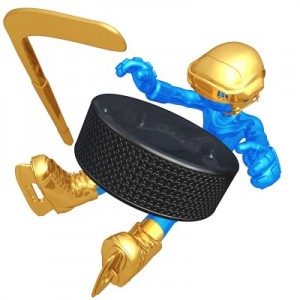07 Mar Marc Staal Hit by Slapshot to Right Eye
 Marc Staal of the New York Rangers was struck in his right eye yesterday by a hockey puck fired by his opponent Kimmo Timonen of the Philadelphia Flyers. The incident has refueled the visor debate. Had the NHL veteran been wearing a visor, the puck would have simply glanced off harmlessly.
Marc Staal of the New York Rangers was struck in his right eye yesterday by a hockey puck fired by his opponent Kimmo Timonen of the Philadelphia Flyers. The incident has refueled the visor debate. Had the NHL veteran been wearing a visor, the puck would have simply glanced off harmlessly.
As we all await status reports about the injury, just what might have happened to his eye?
Blunt Trauma to the Eye
Mr. Staal sustained blunt trauma to the eye. Blunt trauma can be defined as any physical force affecting the eye which does not penetrate the eyeball itself. Non-penetrating blunt trauma is quite common, fist to the eye, tennis ball, etc.
In addition, the hockey puck incident is unique due to the size of the object. The edge of the puck fits nicely between the upper and lower brow, possibly transferring most of the force directly on the eyeball instead of the harder, more sturdy, boney structures making up the eye socket. In contrast, a tennis ball, fist or basketball are too large to fit between the brow bones, thus, protecting the actual eye ball.
Other objects of concern? Golf balls and squash balls. Due to the size of these objects, protective goggles are usually recommended.
Moving from front to the back of the eye, what possible injuries could have been sustained?
Corneal Abrasion
The cornea is the clear tissue in the front of the eye. When a contact lens is worn, it rests on the surface of the cornea. The most superficial layer of the the cornea can be scratched, or abraded, causing intense pain and very blurry vision. The cornea is responsible for 2/3 of focusing power and has lots of nerve endings. Abrasions are painful, but usually heal quickly.
Traumatic Iritis
This is inflammation inside the eye. It often occurs as a result of mild to moderate blunt trauma. Dull ache and mild blurry vision may be usual. This is not unlike having arthritis (another example of inflammation) in the eye. Recovery can take a few days to weeks and may be treated with drops.
Injury to the Lens
On rare occasion, the natural lens could be partially or totally dislocated. While this is unusual, a severe jarring force could dislodge the lens from its natural position. Such a force could also accelerate formation of a cataract.
Retinal Tear/Retinal Detachment
My biggest concern would be whether or not the trauma caused a tear in the retina. A retinal tear can lead to a retinal detachment, a potentially blinding problem. The only way to know for sure is to examine and look for a retinal tear. A retinal tear may be treated to prevent a retinal detachment…if we find the tear before it causes a retinal detachment.
Injury to the Optic Nerve
I’ve included this for the sake of completion. High velocity blunt trauma such as high speed motor accidents and paint ball injuries can actually lead to permanent injury to the optic nerve. While unusual, avulsion of the optic nerve is possible leading to permanent loss of vision.
Ruptured Globe
This is probably the most unlikely, yet most feared. We refer to the eyeball as the “globe.” In this awful situation, the eye is struck so hard…it is squished like a grape and the actual outside coating (the sclera) of the eye rips and tears.
What Does This Mean?
I have no idea what actually happened to his eye. There’s really very little credible information for me to identify an actual injury. My hope is to educate my readers as to what could have happened with such an injury…the blood and gore not withstanding.
I hope he returns quickly. The eye is a tough organ and we have developed an anatomy that protects these vital organs…most of the time.
Randall V. Wong, M.D.
Ophthalmologist, Retina Specialist
Fairfax, Virginia

No Comments